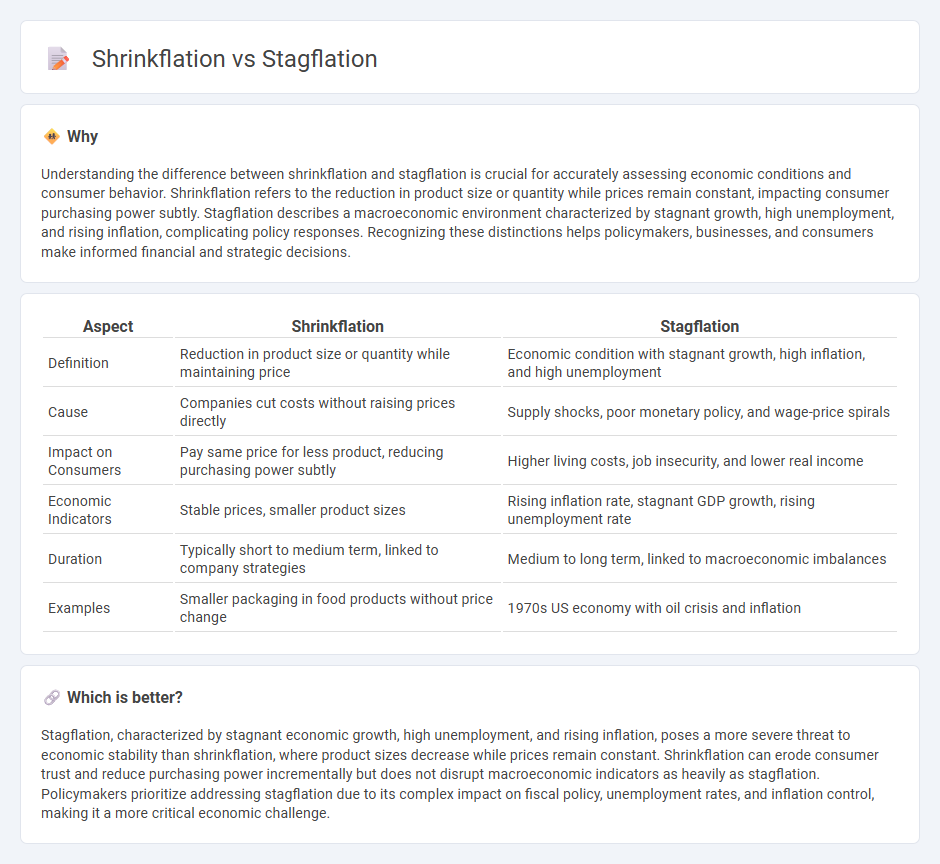
Shrinkflation occurs when companies reduce product sizes while maintaining prices, effectively increasing costs for consumers without obvious price hikes. Stagflation combines stagnant economic growth with high inflation and unemployment, presenting challenges for policymakers and households. Explore the differences and implications of shrinkflation and stagflation for a deeper understanding of economic pressures.
Why it is important
Understanding the difference between shrinkflation and stagflation is crucial for accurately assessing economic conditions and consumer behavior. Shrinkflation refers to the reduction in product size or quantity while prices remain constant, impacting consumer purchasing power subtly. Stagflation describes a macroeconomic environment characterized by stagnant growth, high unemployment, and rising inflation, complicating policy responses. Recognizing these distinctions helps policymakers, businesses, and consumers make informed financial and strategic decisions.
Comparison Table
| Aspect | Shrinkflation | Stagflation |
|---|---|---|
| Definition | Reduction in product size or quantity while maintaining price | Economic condition with stagnant growth, high inflation, and high unemployment |
| Cause | Companies cut costs without raising prices directly | Supply shocks, poor monetary policy, and wage-price spirals |
| Impact on Consumers | Pay same price for less product, reducing purchasing power subtly | Higher living costs, job insecurity, and lower real income |
| Economic Indicators | Stable prices, smaller product sizes | Rising inflation rate, stagnant GDP growth, rising unemployment rate |
| Duration | Typically short to medium term, linked to company strategies | Medium to long term, linked to macroeconomic imbalances |
| Examples | Smaller packaging in food products without price change | 1970s US economy with oil crisis and inflation |
Which is better?
Stagflation, characterized by stagnant economic growth, high unemployment, and rising inflation, poses a more severe threat to economic stability than shrinkflation, where product sizes decrease while prices remain constant. Shrinkflation can erode consumer trust and reduce purchasing power incrementally but does not disrupt macroeconomic indicators as heavily as stagflation. Policymakers prioritize addressing stagflation due to its complex impact on fiscal policy, unemployment rates, and inflation control, making it a more critical economic challenge.
Connection
Shrinkflation and stagflation are connected through their impact on consumer purchasing power and overall economic stagnation. Shrinkflation occurs when companies reduce product sizes while maintaining prices, effectively increasing the cost per unit without raising the sticker price, which exacerbates inflationary pressures experienced during stagflation--a period characterized by high inflation, stagnant economic growth, and rising unemployment. Both phenomena contribute to diminished consumer confidence and reduced real income, complicating monetary policy responses aimed at stabilizing the economy.
Key Terms
**Stagflation:**
Stagflation is a macroeconomic condition characterized by stagnant economic growth, high unemployment, and rising inflation rates simultaneously, creating a challenging environment for policymakers. This phenomenon often results from supply shocks, poor monetary policies, or external economic disruptions, leading to reduced consumer purchasing power and increased cost of living. Explore further to understand how stagflation impacts global markets and potential strategies to mitigate its effects.
Inflation
Stagflation describes a period of high inflation combined with stagnant economic growth and rising unemployment, causing prices to increase even as consumer purchasing power declines. Shrinkflation occurs when product sizes shrink but prices remain the same, effectively increasing the price per unit and contributing to inflation without obvious price hikes. Explore deeper insights on how these inflation phenomena impact markets and consumer behavior.
Unemployment
Stagflation is characterized by high inflation, stagnant economic growth, and rising unemployment, creating a challenging labor market with reduced job opportunities. Shrinkflation, on the other hand, involves product downsizing amid stable unemployment rates, thus not directly impacting overall joblessness but affecting consumer purchasing power. Explore detailed insights on how these economic phenomena influence unemployment trends and labor markets.
Source and External Links
Overview, Examples, Why Stagflation is Feared - Stagflation is an economic event defined by high inflation, slow economic growth, and steadily high unemployment, posing a policy dilemma as measures to reduce inflation can worsen unemployment and vice versa, with major causes including supply shocks and poor economic policies, exemplified notably in the 1970s U.S.
Stagflation - Stagflation combines high inflation, stagnant growth, and elevated unemployment, challenging traditional economic theories and often caused by supply shocks like the 1973 oil crisis or misguided government policies, leading to significant shifts in economic thinking in the 1970s.
a stagflation primer - Stagflation is the coexistence of high inflation, stagnant or declining GDP growth, and rising unemployment, creating a painful economic scenario where inflation expectations may remain unanchored despite economic stagnation, raising the "misery index" to record levels.
 dowidth.com
dowidth.com